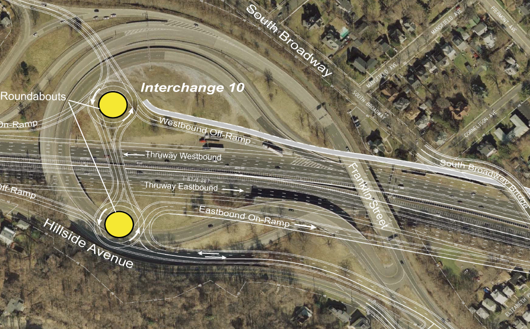
One of the proposed I-287 S. Nyack Exit 10 reconfigurations. These plans were scuttled with the announcement of the fix-the-bridge-only plan from the NYS DOT in Oct 2011.
by Arthur H. Gunther III
Ever wonder why there’s a 360 degree exit ramp to reach South Nyack on I-287 West after crossing the Tappan Zee Bridge? It’s all part of a never executed 1950’s plan to connect the NJ Turnpike to the Tappan Zee Bridge.
SOUTH NYACK, N.Y. — Ever since President Eisenhower, with German Autobahn images fresh in his mind encouraged by car manufacturers and trucking companies, decided to fashion the interstate highway system, localities — the sort that built small-town America — have not counted as much. This is said to be for the greater good, but in the rush to progress, heritage has been lost and so has respect for humble beginnings.
In this South Nyack village just 22 miles north of New York City but a world apart from Gotham, in this community where Carson McCullers had Tennessee Williams to tea and other beverages, the nation and the New York governor want to build a very big bridge, actually two of them, side by side over the Hudson River. The crossings are to replace the 1955 Tappan Zee Bridge, a structure now discovered to have been constructed on the cheap, and quickly, so as to bring a ‘cash register’ to the New York State Thruway and pay off the bonds. Truckers were happy to oblige in this early addition to a fledgling interstate system, forgoing rail and accepting breaks on tariff charges. But that has greatly increased traffic beyond any expectation and has so stressed the present crossing that government and engineers say it must go. A “shovel-ready, job-making” replacement is in the works, but as with the first bridge, South Nyack is to get no respect.
When the Tappan Zee was constructed in the early 1950s, the village lost its entire downtown and some 200 houses to eminent domain and to the greater good. Even more land was taken for a very large cloverleaf that was to connect to a New York extension of the then-developing New Jersey Turnpike. That never happened, and the cloverleaf remains overwhelming and confusing to this day, taking up more real estate than necessary.
The new bridge’s approach will not remove the unnecessary cloverleaf. No money says the government. Yet given the initial projected cost of the two new bridges, about $6 billion, what is a few million more to take away what took away the community downtown, to provide land for a new village center, to raise the possibility of private investment in small shops, a park, a walkable area, to give what was small-town America a reason to smile though it covers its ears from interstate clamor?
What is this to you, you might ask, those who read this column from afar? You don’t know South Nyack. No, but you do know the small town where you might have been raised, or where your grandmother lived, or like the ones you saw in old Hollywood movies. You should care about South Nyack, I humbly suggest, because it and other villages like it are part of the woven national fabric, even if in the big picture we don’t see the smaller parts of the quilt, so handsomely fashioned.
The United States has come very far in its national progress, conquering one frontier after another, improving the quality of life, building a middle class, providing opportunity. But in that never-ending march that is our DNA, we have, deliberately or not, trodden over our humble beginnings. Interstates are important, but so are downtowns.
Editor’s Note: Gunther says that planning for the New York State Thruway preceded discussion of the TZB and the Thruway was initially intended to end at Suffern with a connector to the Garden State Turnpike. The bonds required to build the Thruway required significant toll revenue — part of the rationale for building the Tappan Zee Bridge where it now sits, just North of where it would fall under the Port Authority’s jurisdiction. Gunther adds that credit for the “Tappan Zee Bridge” name goes to former Rockland Journal News Editor Norman Baker, who first suggested the title.
“Construction of the extension was to provide a more direct bypass of the New York City area via the Tappan Zee Bridge to New England,” writes NycRoads.com. “The Bergen County section of the New Jersey Turnpike Extension was to be built by the New Jersey Turnpike Authority, while the Rockland County section was to be constructed by the New York State Thruway Authority.”
The proposed New Jersey Turnpike Extension would have paralleled NY 303 and the CSX / Conrail train with interchanges at the Palisades Interstate Parkway in Orangeburg and the NYS Thruway. The plan was abandoned in the late 1960’s after strong local opposition and rising property acquisition costs.
Arthur H. Gunther, a retired Rockland County newspaperman, writes weekly at TheColumnRule.com.
See also:
- Funding Still in Flux For New TZB — plans for reconfigured I-287 Exit 10, 10/16/2010
- As Others See Us: TZB A Big Bridge In The Wrong Place, 8/11/2011
- The Turnpike Extension To Rockland County,” NYCRoads.com








